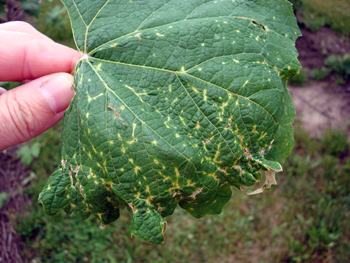Preventing grape Phomopsis infection of rachis and fruit
Susceptible varieties of grapes are showing cane and leaf lesions.
Cane and leaf lesions have been showing up in high numbers in susceptible varieties. Each rainfall event will lead to spore dispersal and can also lead to successful infection if the tissue remains wet for a sufficient amount of time. The optimum temperature for infection is 59 to 68ºF, at which time about 6 to 10 hours of wetness are needed for infection. The longer the tissue stays wet, the more severe the symptoms will be. At this time we should be concerned with preventing Phomopsis infection of the rachis and fruit, especially in mechanically pruned vineyards and vineyards with a history of the disease. Rachis infections are most closely correlated with yield losses due to berry drop at harvest in Niagara vines, whereas fruit infections are more of a problem in wine grapes.
If at this time you find a lot of lesions on the leaves and canes, infection pressure will be high for the fruit also. It is not too late to apply fungicides for cluster protection from Phomopsis. The best fungicide options for control of Phomopsis during and after bloom are Abound, Sovran, Flint, or Pristine (do not use Pristine on Concord grapes). Phosphorous acid fungicides such as ProPhyt and Phostrol are also good and cost-effective alternatives. These are systemic and will likely provide some kick-back activity. In trials done in Michigan, ProPhyt provided very good control of Phomopsis when sprayed on a 14-day schedule. Tighten the schedule and increase the rate if disease pressure is high. Ziram is a moderate to good protectant against Phomopsis and can be a tank-mix partner with any of the phosphorous acid fungicides. EBDC fungicides and Captan are good protectants but cannot be applied after bloom has started in grapes grown for the National Grape Cooperative. EBDC’s have a 66-day pre-harvest interval.

Phomopsis lesions on grape leaf.
Dr. Schilder's work is funded in part by MSU's AgBioResearch.



 Print
Print Email
Email


